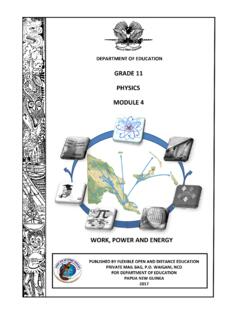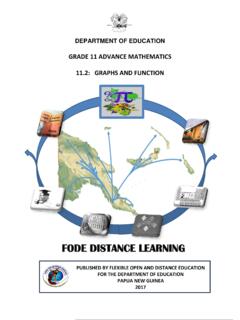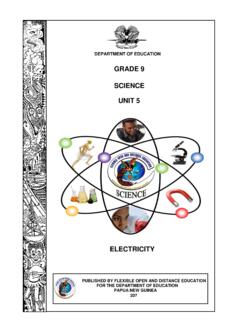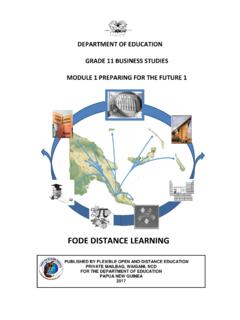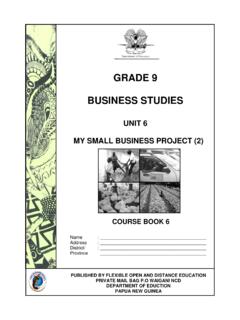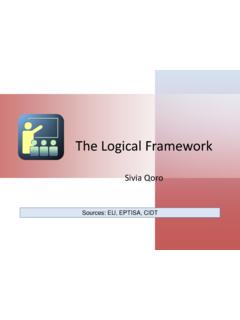Transcription of GRADE 9 Topic MATHEMATICS - FODE | Home
1 Topic Topic Published by: DEPARTMENT OF EDUCATION FLEXIBLE OPEN AND DISTANCE EDUCATION PRIVATE MAIL BAG, WAIGANI, NCD FOR DEPARTMENT OF EDUCATION papua NEW guinea 2013 MATHEMATICS GRADE 9 UNIT 4 STATISTICS GRAPHS AND PROBABILITIES GR 9 MATHEMATICS U4 1 Topic 1 TITLE UNIT 4 STATISTICS GRAPHS AND PROBABILITIES Topic 1: READING & INTERPRETING GRAPHS Topic 2: STRAIGHT LINE GRAPHS Topic 3: PROBABILITIES Topic 4: STATISTICAL ESTIMATION GR 9 MATHEMATICS U4 2 ACKNOWLEDGEMENT Flexible Open and Distance Education papua New guinea Published in 2016 @ Copyright 2016, Department of Education papua New guinea All rights reserved.
2 No part of this publication may be reproduced, stored in a retrieval system, or transmitted in any form or by any means electronic, mechanical, photocopying, recording or any other form of reproduction by any process is allowed without the prior permission of the publisher. ISBN: 978-9980-87-735-2 National Library Services of papua New guinea Written by: Mr. Renato Ortega Mrs. Luzviminda B. Fernandez Finalised and compiled by: Mrs. Luzviminda B. Fernandez MATHEMATICS Department-FODE Printed by the Flexible, Open and Distance Education Acknowledgements We acknowledge the contribution of all Secondary teachers who in one way or another helped to develop this Course. Special thanks are given to the staff of the MATHEMATICS Department- FODE who played active role in coordinating writing workshops, outsourcing of lesson writing and editing processes involving selected teachers in Central and NCD.
3 We also acknowledge the professional guidance and services provided through-out the processes of writing by the members of: MATHEMATICS Department- CDAD MATHEMATICS Subject Review Committee-FODE Academic Advisory Committee-FODE This book was developed with the invaluable support and co-funding of the GO-PNG/FODE World Bank Project. MR. DEMAS TONGOGO Principal-FODE GR 9 MATHEMATICS U4 3 CONTENTS CONTENTS Page Contents Secretary s Message Unit Introduction Study Guide Topic 1: READING AND INTERPRETING GRAPHS Lesson 1: Reading Bar Graphs Lesson 2: Reading Histogram Lesson 3: Interpolation and Extrapolation Lesson 4: Population Pyramids Lesson 5.
4 Travel Graphs Summary Answers to Practice Exercises 1-5 Topic 2: STRAIGHT LINE GRAPHS Lesson 6: Cartesian Plane Lesson 7: The Gradient Lesson 8: Drawing Straight Line Graph Lesson 9: Equation of a Straight Line Summary Answers to Practice Exercises Topic 3: PROBABILITIES Lesson 10: Basic Concepts of Probability Lesson 11: Theoretical Probability Lesson 12: Probability of Complementary Events. Lesson 13: Adding Probabilities Lesson 14: Multiplying Probabilities Lesson 15: Union and Intersection of Events Lesson 16: Mixed Probability Problems Summary Answers to Practice Exercise 10 16 Topic 4: SYSTEMS OF EQUATIONS Lesson 17: Population and Sample Lesson 18: Sampling Methods Lesson 19: Survey Summary: Answers to Practice Exercises 17 19: REFERENCES.
5 3 4 5 6 7 9 15 20 27 32 36 37 41 43 48 55 63 68 69 73 75 83 89 96 103 110 118 124 125 129 131 143 152 157 158 160 GR 9 MATHEMATICS U4 4 MESSAGE SECRETARY S MESSAGE Achieving a better future by individuals students, their families, communities or the nation as a whole, depends on the curriculum and the way it is delivered. This course is part and parcel of the new reformed curriculum the Outcome Base Education (OBE). Its learning outcomes are student centred and written in terms that allow them to be demonstrated, assessed and measured. It maintains the rationale, goals, aims and principles of the national OBE curriculum and identifies the knowledge, skills, attitudes and values that students should achieve.
6 This is a provision of Flexible, Open and Distance Education as a alternative pathway of formal education. The Course promotes papua New guinea values and beliefs which are found in our constitution, Government policies and reports. It is developed in line with the National Education Plan (2005 2014) and addresses an increase in the number of school leavers which has been coupled with a limited access to secondary and higher educational institutions. Flexible, Open and Distance Education is guided by the Department of Education s Mission which is fivefold; to facilitate and promote integral development of every individual to develop and encourage an education system which satisfies the requirements of papua New guinea and its people to establish, preserve, and improve standards of education throughout papua New guinea to make the benefits of such education available as widely as possible to all of the people to make education accessible to the physically, mentally and socially handicapped as well as to those who are educationally disadvantaged The College is enhanced to provide alternative and comparable path ways for students and adults to complete their education, through one system, many path ways and same learning outcomes.
7 It is our vision that papua New Guineans harness all appropriate and affordable technologies to pursue this program. I commend all those teachers, curriculum writers and instructional designers, who have contributed so much in developing this course. GR 9 MATHEMATICS U4 5 INTRODUCTION Unit Introduction Dear Student, This is the Fourth Unit of the GRADE 9 MATHEMATICS Course. It is based on the CDAD Lower Secondary Syllabus and Curriculum Framework for GRADE 9 This Unit consists of four topics: Topic 1: Reading and Interpreting Graphs Topic 2: Straight Line Graphs Topic 3: Probabilities Topic 4: Statistical Estimation In Topic 1- Reading and Interpreting Graphs- You will learn to read and use MATHEMATICS to interpret different types of graphs In Topic 2- Straight Line Graphs- You will learn to explore the Number Plane, draw line graphs, learn the importance of gradient and write the equation of a straight line.
8 In Topic 3- Probability- You will learn the language of chance, and calculate the chance of something happening. Furthermore, you will explore the different ways to compute probabilities. In Topic 4- Statistical Estimation- You will learn to use Statistics to estimate different aspect of samples and population parameters. You will also learn the different sampling methods. You will find that each lesson has reading materials to study, worked examples to help you, and a Practice Exercise. The answers to practice exercise are given at the end of each Topic . All the lessons are written in simple language with comic characters to guide you and many worked examples to help you. The practice exercises are graded to help you to learn the process of working out problems.
9 We hope you enjoy using this unit. MATHEMATICS Department FODE GR 9 MATHEMATICS U4 6 STUDY GUIDE STUDY GUIDE Follow the steps given below as you work through the Unit. Step 1: Start with Topic 1 Lesson 1 and work through it. Step 2: When you complete Lesson 1, do Practice Exercise 1. Step 3: After you have completed Practice Exercise 1, check your work. The answers are given at the end of Topic 1. Step 4: Then, revise Lesson 1 and correct your mistakes, if any. Step 5: When you have completed all these steps, tick the Lesson check-box on the Contents Page like this: Lesson 1: Reading and Interpreting graphs Then go on to the next Lesson. Repeat the process until you complete all of the lessons in Sub-strand 1. Step 6: Revise the Topic using Topic 1 Summary, then, do Topic test 1 in Assignment 1.
10 Then go on to the next Topic . Repeat the process until you complete all of the four Topics in Unit 1. Assignment: (Four Topic Tests and a Unit Test) When you have revised each Topic using the Topic Summary, do the Topic Test in your Assignment Book. The Course Book tells you when to do each Topic Test. When you have completed the four Topic Tests, revise well and do the Topic test. The Assignment Book tells you when to do the Unit Test. Remember, if you score less than 50% in three Assignments, you will not be allowed to continue. So, work carefully and make sure that you pass all of the Assignments. The Topic Tests and the Unit test in the Assignment will be marked by your Distance Teacher. The marks you score in each Assignment Book will count towards your final mark.
